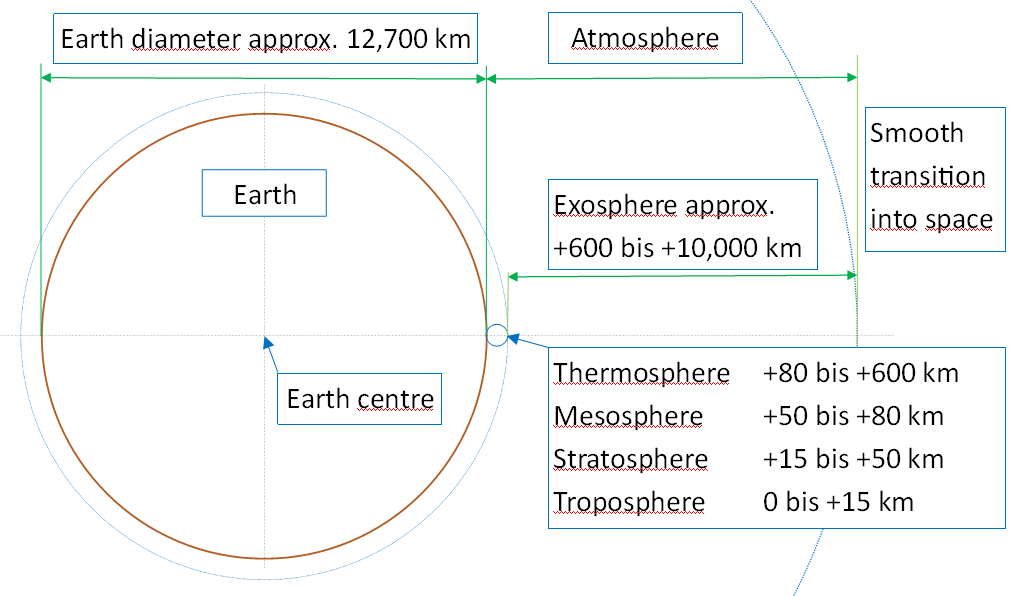The complete gas envelope surrounding the Earth is called the atmosphere. A distinction is made between five different gas layers.
The essential things for our lives take place in the lower 1 - 1.5 per mille of the entire atmosphere.

The diagram shows the structure of the complete air shell in the actual relations. The indicated heights of the layers vary, e.g. for the tropopause (transition troposphere/stratosphere) between 8 and 15 km, for the mesopause (transition mesosphere/thermosphere) between 50 and 80 km. These variations are irrelevant, however, as these boundaries do not appear as actual boundary layers.
The entire atmosphere is a continuous mixture of gases that weighs down on the Earth's sphere due to gravity and becomes thinner and thinner in density from bottom to top. The main gases are nitrogen with approx. 78 %, oxygen with approx. 20 %, inert gases with 1 % and the rest trace gases such as water vapour, carbon dioxide (CO2), methane (CH4) and ozone (O3).
The air pressure is the sum of the partial pressures of the single gases.
Exosphere
The exosphere is the outermost and spatially most powerful layer of the atmosphere. The exosphere merges smoothly into interstellar space. Due to the extremely low gas density and the high intensity of the electromagnetic radiation from the sun, the gas molecules move at high speed and at a great distance. Theoretically, the temperatures would be far above 1000° Celsius, provided there was appropriate matter there for absorption. Due to the high intensity of UV radiation, all gas molecules are ionised. Electromagnetic rays can pass through the exosphere without resistance in all directions. On the sunny side to the Earth and in the shadowed area from the Earth into space.
Thermosphere
The thermosphere follows the exosphere (range between 80 and approx. 600 km above the Earth's surface). The air density here is still extremely low and the theoretical temperatures are 300 °C at night and about 1500 °C during the day, i.e. conditions similar to those in the exosphere. Spacecraft and satellites orbit the Earth in the thermosphere. The thermosphere is also no barrier to electromagnetic radiation.
Mesosphere
In the mesosphere, i.e. the middle layer between 50 and 80 km altitude, the gas shell slowly begins to become denser. Its density starts at 0.05 per mille and reaches up to 2 per mille of the air density at sea level. However, this density is already sufficient to cause smaller meteorites that enter the Earth's gravitational field at very high speed to burn up due to friction, which we can then see as shooting stars. In the mesosphere, it can get as cold as - 100 °C in the higher layers, therefore this layer is considered the coldest layer in the atmosphere.
Stratosphere
In the stratosphere (15 to 50 km above the Earth's surface), the temperature increases from about - 80 °C at the tropopause (layer close to the Earth) to about 0 °C at the stratopause (layer far from the Earth). The vital ozone layer, which is responsible for the temperature increase in the stratosphere, is located in the middle to upper area of the stratosphere. Energy-rich UV radiation from the sun is absorbed here and converted into heat, thus protecting our habitat from harmful UV radiation.
Troposphere
The troposphere is spatially the thinnest layer, but 80-90% of the total air mass and almost all of the water vapour in the atmosphere is found here. It is the layer in which we live, our habitat.
This habitat on Earth receives the necessary warmth from the sun. With increasing altitude, the temperature decreases by 6.5-8 °C per 1000 m to as low as - 80 °C at the tropopause. This temperature decrease is physically caused by the decreasing gas density!
Atmospheric boundary layer
The lower layer of the atmosphere, 2000 m high, is also called the atmospheric boundary layer. This layer is influenced by the Earth's surface as well as the water surface, e.g. by temperature, humidity, resistance due to elevations, etc.
This raises the question: How can it get warm in the lower layer of the troposphere and become warmer and warmer, when at an altitude of 10 to 15 km temperatures of up to -80° C already prevail and warm air masses are known to rise?


